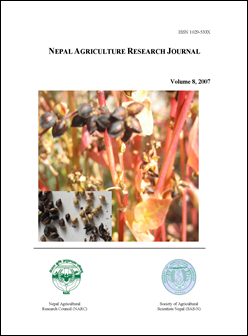Identification of Suitable Planting Method for Potato + Maize Intercropping System in the Hill of Eastern Nepal
DOI:
https://doi.org/10.3126/narj.v8i0.11604Keywords:
Effect, Intercropping, Maize, Planting method, PotatoAbstract
Field experiments to identify suitable planting method under potato + maize system in the high hill (2200 m) of eastern Nepal Sindhuwa, Dhankuta, was conducted during 2000 and 2001 seasons for the potato variety Hale and maize variety Ganesh 1. Of the different planting methods tested, significantly the highest yield of potato (15.5 t/ha) was recorded from the alternate row planting followed by recommended practice and flat row planting. Early emergence (by 7-12 days) was in farmers' practice, whereas uniform plants (1-5 scale) observed in flat row and double row planting. Maize did not follow this trend. Double row and farmer's practice favored good ground coverage (80-95%) by potato plants, which attained height from 49.8cm (farmer's practice) to 56.8 cm (flat row). Number of main stems/plant was higher in all treatments, except farmer's practice. Similar trend was followed in tuber numbers. Maturity of crops did not depend on planting methods. Final stand of potato ranged between 46.9 (alternate row) and 68.6 thousand/ha (farmer's practice). Late blight and bacterial wilt infection was higher in the farmers' practice. The height of maize plants was significantly differed between sole cropping (220 cm), which yielded higher followed by alternate row (183 cm) and flat row plantings. Gross income from maize and potato was higher in flat row planting. The data revealed that alternate row and flat row planting methods were superior over the common farmers' practice and the recommended practice, so the identified planting methods were recommended.
Nepal Agric. Res. J. Vol. 8, 2007, pp. 113-119
Downloads
Downloads
Published
How to Cite
Issue
Section
License
This license allows reusers to copy and distribute the material in any medium or format in unadapted form only, for noncommercial purposes only, and only so long as attribution is given to the creator.




